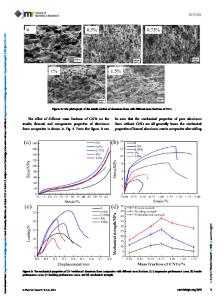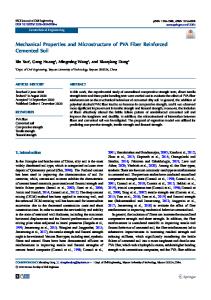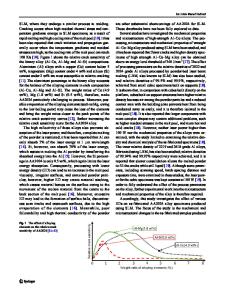Effects of sintering parameters on the microstructure and mechanical properties of carbon nanotubes reinforced aluminum
- PDF / 684,425 Bytes
- 9 Pages / 584.957 x 782.986 pts Page_size
- 60 Downloads / 401 Views
By using high purity aluminum powders and multi-walled carbon nanotubes (MWCNTs) as raw materials, MWCNTs/Al composites were fabricated with ball milling, followed by cold pressing, vacuum sintering, and hot extrusion. It was found that when the sintering temperature was 863 K, MWCNTs/Al composite sintered for 4 h showed good comprehensive properties, and its tensile strength and elongation reached to 156 MPa and 21%, respectively. The comprehensive mechanical properties of the composites became better with raising sintering temperature when the sintering time was 4 h. When the sintering temperature raised to 923 K, the tensile strength of the composite reached to 167 MPa which is three times more than that of annealed high purity aluminum, mainly due to the higher density and better interface bonding resulted from higher sintering temperature. CNTs’ pulling out were observed obviously in the fractured surfaces, and load transfer may be the main strengthening mechanism.
I. INTRODUCTION
Owing to their light weight, good corrosion resistance, and deformation properties, aluminum alloys and its composites are the most abundantly used nonferrous structural materials in aerospace, ground transportation, and military industry. 1 Meanwhile, carbon nanotubes (CNTs) possess extraordinary mechanical, thermal, and electrical properties.2,3 Their density is just 1.2–1.8 g/cm3, but their tensile strength is one hundred times as high as that of high strength steel. Additionally, it has high aspect ratio, ultra-high specific modulus,4–7 flexibility,8 and low coefficient of thermal expansion. Thus, all of these unimaginable characteristics render carbon nanotubes an ideal reinforcement for aluminum matrix composites,9,10 which offers an efficient approach to meet the special demands of various industries, such as aerospace and automotive materials.2 Some researchers have explored the effects of CNTs addition on the mechanical properties of final composites. Kwon et al.11 mixed MWCNTs with pure aluminum powders by mechanical ball milling, and then produced MWCNTs/Al composites by vacuum hot pressing. Park et al.12 investigated the effects of CNTs addition on the mechanical properties and a 60 and 23% increase in yield strength and tensile strength were observed for 0.2 wt%
CNTs content. Similarly, Bradbury et al.13 prepared the composites with various CNTs addition of 1–9 wt% by ball milling and then hot pressing, and the composite attained the highest hardness when the CNTs addition was 6 wt%. However, apart from the CNTs addition, specific sintering parameters like sintering time and temperature also significantly influence the mechanical properties of the final composites prepared by powder metallurgy method. Van Trinh et al.14 studied the effects of sintering temperature on the mechanical properties of Cu/CNTs nanocomposites prepared via a powder metallurgy method. It was revealed that the density and hardness simultaneously changed with the sintering temperature and the optimal sintering temperature was determined to be 1173 K at wh
Data Loading...











